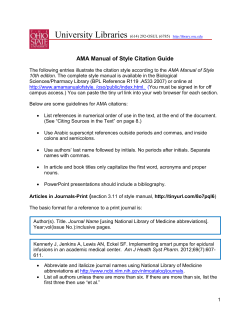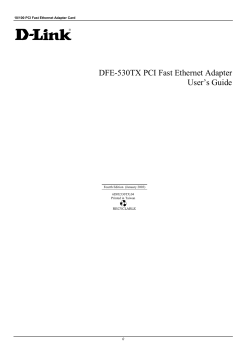
R A EDIRECTS AND LIASES
REDIRECTS AND ALIASES
Properly Recording Data when Using Redirects
February 23, 2006
Version 1.0
CHAPTER 1
1 Redirects and Aliases
Redirects point the browser to a new location without user interaction. They are executed at either the web browser
(client-side redirect) or at the web server (server-side redirect). Because redirects do not require any user interaction,
redirects are often executed without the user ever noticing. The only thing that indicates a redirect has occurred is the
browser's address bar. The address bar displays a URL that is different from the link the browser initially requested.
Although there are only two types of redirects, they can be implemented in numerous ways. For example, client-side
redirects can occur because the web page to which a user has pointed his or her browser contains scripting or
special HTML code that redirects the browser to another URL. Server-side redirects can occur because the page
contains server-side scripting or because the web server has been configured to point the user to another URL.
1.1 SiteCatalyst and Redirects
SiteCatalyst gathers some of its data from the browser, and relies upon certain browser properties. Two of those
properties, the "Referring URL" (or "referrer") and the "Current URL" can be changed by a server-side redirect. Since
the browser is aware that one URL has been requested, but a different URL has been returned, it clears the Referring
URL. The result is the referring URL is blank, and SiteCatalyst may report that no referrer existed for the page.
1.1.1 Example: Browsing Without Redirects
Consider the following hypothetical scenario in which the user does not encounter a redirect:
1.
User points her browser to www.google.com, and types, discount airline tickets into the search field, and then
clicks the Search button.
2.
The browser displays the search results including a link to your site, http://www.flywithus.com/. After displaying
the search results, the browser's address bar displays the search terms that the user entered in the search field
(http://www.google.com/search?hl=en&ie=UTF-8&q=discount+airline+tickets). Notice that the search terms are
included in the URL query string parameters that follow http://www.google.com/search?.
3.
The user clicks on the link to your hypothetical site http://www.flywithus.com/. When the user clicks on this link
and lands on the flywithus.com web site, SiteCatalyst uses JavaScript to collect the referring URL
(http://www.google.com/search?hl=en&ie=UTF-8&q=discount+airline+tickets) as well as the current URL
(http://www.flywithus.com/).
4.
SiteCatalyst reports the information collected during this interaction in various reports, such as Referring
Domains, Search Engines, and Search Keywords.
1.1.2 Example: Browsing With Redirects
Redirects can cause the browser to blank out the true referring URL. Consider the following scenario:
1.
User points her browser to www.google.com, and types, discount airline tickets into the search field, and then
clicks the Search button.
2.
The browser window s address bar displays the search terms that the user typed into the search field
(http://www.google.com/search?hl=en&ie=UTF-8&q=discount+airline+tickets). Notice that the search terms are
included in the URL query string parameters that follow "http://www.google.com/search?". The browser also
displays a page that contains the search results including a link to one of your domain names:
http://www.flytohawaiiforfree.com/. This vanity domain is configured to redirect the user to
http://www.flywithus.com/.
3.
The user clicks on the link http://www.flytohawaiiforfree.com/ and is redirected by the server to your main site,
http://www.flywithus.com. When t h e redi r ec ti o n occurs, t h e da ta t ha t is i m p o r ta n t t o SiteCatalyst
data collecti on is lost because t he br o wser clears t h e ref erri ng URL. Thus, the original search
information used in the SiteCatalyst reports (i.e., Referring Domains, Search Engines, Search Keywords) is lost.
Redirects and Aliases
1
REDIRECTS AND ALIASES
Implementing Redirects for SiteCatalyst in this document discusses how to leverage SiteCatalyst variables to capture
the data lost in the re-direct. Specifically, the section discusses how to fix the "discount airline tickets" situation
described above.
1.2 Implementing Redirects for SiteCatalyst
In order to capture SiteCatalyst data from redirects, four minor alterations need to be made to the code that creates
the redirect and the SiteCatalyst .JS file. The following steps will retain the information that the original referrer (e.g.
http://www.google.com/search?hl=en&ie=UTF-8&q=discount+airline+tickets in the scenario above) passes to your
site.
1.2.1 Configure Referrer Override JavaScript Code
Omniture Live Support can provide you with a JavaScript file that contains code that will override the default
functionality SiteCatalyst uses to capture the referrer from the HTTP header. The code snippet below shows two
JavaScript variables, s_referrer and s_pageURL. This code is placed on the ultimate landing page of the redirect.
G Code
<!-- SiteCatalyst code version: H.0.
Copyright 1997-2005 Omniture, Inc. More info available at
http://www.omniture.com -->
<script language="JavaScript" src="//INSERT-DOMAIN-AND-PATH-TO-CODEHERE/s_code.js"></script>
<script language="JavaScript"><!-/* You may give each page an identifying name, server, and channel on
the next lines. */var s_pageName=""
var s_server=""
var s_campaign=""
var s_referrer=""
var s_pageURL=""
H Code
<!-- SiteCatalyst code version: H.0.
Copyright 1997-2005 Omniture, Inc. More info available at
http://www.omniture.com -->
<script language="JavaScript" src="//INSERT-DOMAIN-AND-PATH-TO-CODEHERE/s_code.js"></script>
<script language="JavaScript"><!-/* You may give each page an identifying name, server, and channel on
the next lines. */
s.pageName=""
s.server=""
s.campaign=""
s.referrer=""
s.pageURL=""
1.2.2 Modify the Redirect Mechanism
Because the browser strips referring URL, you must configure the mechanism that handles the redirect (e.g. the web
server, server-side code, client-side code) to pass along the original referrer information. If you would also like to
record the alias link URL, this must also be passed along to the ultimate landing page. Use the s_pageURL variable
to override the current URL.
Redirects and Aliases
2
REDIRECTS AND ALIASES
Since there are many ways to implement a redirect, you may need to check with your web operations group to
identify the specific mechanisms that execute redirects on your web site. The example below shows how one might
pass along the original referrer and alias link information to the ultimate landing page using a client side redirect
mechanism.
Since there are many ways to implement a redirect, you may need to check with your web operations group or your
online advertising partner to identify the specific mechanisms that execute redirects on your web site.
1.2.3 Capture the Original Referrer
Normally, SiteCatalyst will obtain the referring URL from the browser's document.referrer property, and the current
URL from the document.location property. By passing values to the referrer and pageURL variables, you can override
the default processing. By passing a value to the referrer variable, you are telling SiteCatalyst to ignore the referrer
information in the document.referrer property and to use an alternative value that you define.
Therefore, the final version of the landing page would need to contain the following code to correct the issues
introduced in the "discount airline tickets" scenario.
G Code
<!-- SiteCatalyst code version: G.7.
Copyright 1997-2004 Omniture, Inc. More info available at
http://www.omniture.com --><script language="JavaScript"><!-/* You may give each page an identifying name, server, and channel on
the next lines. */
var s_pageName=""
var s_server=""
var s_campaign=""
var s_referrer="http://www.google.com/search?hl=en&ie=UTF8&q=discount+airline+tickets"
// Setting the s_pageURL variable is optional.
var s_pageURL=http://www.flytohawaiiforfree.com
H Code
<!-- SiteCatalyst code version: H.0.
Copyright 1997-2005 Omniture, Inc. More info available at
http://www.omniture.com -->
<script language="JavaScript" src="http://INSERT-DOMAIN-AND-PATH-TO-CODEHERE/s_code.js"></script>
<script language="JavaScript"><!-/* You may give each page an identifying name, server, and channel on
the next lines. */
s.pageName=""
s.server=""
s.campaign=""
s.referrer=http://www.google.com/search?hl=en&ie=UTF-8&q=discount+airline+tickets
// Setting the s.pageURL variable is optional.
s.pageURL="http://www.flytohawaiiforfree.com"
1.2.4 Verify Referrer with the SiteCatalyst Debugger
Run a test to verify that the referrer, originating URL (s_server) and campaign variables are being captured. These
variables will be represented as the following parameters in the SiteCatalyst Debugger.
Redirects and Aliases
3
REDIRECTS AND ALIASES
URL or Query String Value
Value as Shown in the SiteCatalyst Debugger
http://www.google.com/search%3F
hl%3Den
%26ie%3DUTF826q%3
Ddiscount%2Bairline%2Btickets
r=http:/ref=www.google.com/search?hl=en&ie=UTF
-8&q=discount+airline+tickets
Page
URL
http://www.flytohawaiiforfree.com
g=http://www.flytohawaiiforfree.com
Ultimate
Landing
Page
URL
http://www.flywithus.com
Original
Referrer
This value will appear in the SiteCatalyst debugger if the
pageURL variable is used
This value will NOT appear in the SiteCatalyst debugger if the
pageURL variable is used
The text that the debugger displays should correspond to the following example.
Image
http://flywithuscom.112.2o7.net/b/ss/flywithuscom/1/H.0-Pd-R/s61944015791667?[AQB]
ndh=1
t=11/5/2004 12:4:57 5 360
pageName=Welcome to FlyWithUs.com
r=http://ref=www.google.com/search?hl=en&ie=UTF-8&q=discount+airline+tickets
cc=USD
g=http://www.flytohawaiiforfree.com
s=1280x1024
c=32
j=1.3
v=Y
k=Y
bw=1029
bh=716
ct=lan
hp=N
[AQE]
After verifying that the SiteCatalyst debugger displays these variables, it is always helpful to confirm that the search
terms and the original referring domain (prior to the redirect) are registering traffic in the SiteCatalyst interface.
1.3 Notes
You might be tempted to use SiteCatalyst's getQueryParam plug-in to populate the referrer variable and the
pageURL variables with the original referrer and the alias link. While the getQueryParam plug-in is an easy way to
populate SiteCatalyst variables with query string values, it must be implemented in connection with a temporary
variable so that legitimate referrers are not overwritten when the query string is empty. The best way to use
getQueryParam is in connection with the getValue plug in as outlined with the following pseudo-code, which should
be added to the "doPlugins()" function within the "s_code_remote.js" or "s_code.js" file as shown below.
1.3.1 G Code
/* Plugin Config */
s_usePlugins=true
Redirects and Aliases
4
REDIRECTS AND ALIASES
function s_doPlugins(){
/* Add calls to plugins here */
s_vp_getQueryParam('tempVar','origref');
if(s_vp_getValue('tempVar'))
s_vp_getQueryParam('s_referrer',"origref');
1.3.2 H Code
/* Plugin Config */
s.usePlugins=true
function s_doPlugins(s) {
/* Add calls to plugins here */
// Copy original referrer into s.referrer if it exists
var tempVar
tempVar=s.getQueryParam('origref')
if(tempVar)
s.referrer=tempVar;
}
s.doPlugins=s_doPlugins
Redirects and Aliases
5
CALL 1.877.722.7088
1.801.722.0139
550 East Timpanogos Circle
Orem, Utah 84097
www.omniture.com
info@omniture.com
© Copyright 2025











